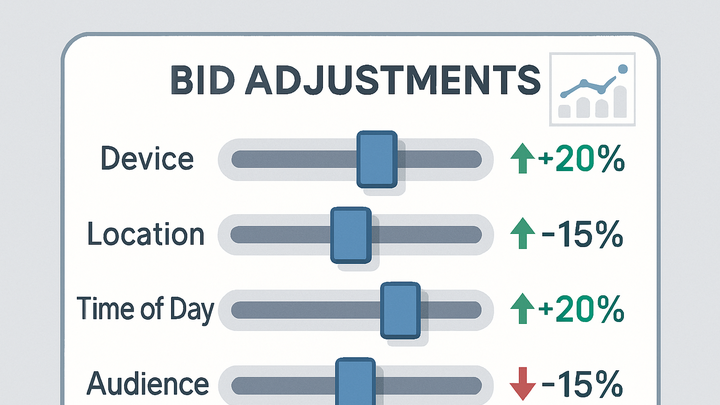Published on 2025-06-22T06:44:25Z
What is Bid Adjustment? Examples and Best Practices
Bid adjustment is a mechanism in pay-per-click (PPC) advertising that allows marketers to increase or decrease their bids based on specific targeting criteria—such as device type, geographic location, time of day, or audience segments—to optimize return on ad spend (ROAS) and budget efficiency. By applying percentage-based bid modifiers, you can allocate more budget to high-value segments (e.g., mobile users who convert at higher rates) and reduce spend on underperforming ones. Platforms like Google Ads support bid adjustments natively, while analytics tools such as GA4 and PlainSignal can track the real-world impact of these changes. Effective bid adjustment strategies rely on sufficient data, incremental testing, and continuous monitoring to respond to evolving performance trends.
Bid adjustment
A PPC tactic to raise or lower bids for specific segments (device, location, time, audience) to boost ROI and budget efficiency.
Why Bid Adjustments Matter
Bid adjustments give advertisers granular control over ad spend, enabling them to invest more in high-performing segments and pull back on low-value ones. This targeted approach drives better ROI, improves competitive positioning, and ensures budgets are allocated where they have the greatest impact.
-
Budget allocation control
Allocate more budget to audiences, devices, or times that yield higher conversion rates, and reduce spend on underperforming segments.
-
Performance optimization
Respond to real-time performance data by increasing bids for segments that show strong engagement or conversion signals.
-
Competitive advantage
Outbid competitors in high-value contexts—such as prime geographic markets or peak shopping hours—to capture more qualified traffic.
Types of Bid Adjustments
Advertisers can apply bid modifiers across various dimensions to fine-tune their campaigns:
-
Device-based adjustments
Modify bids separately for desktop, tablet, and mobile devices according to their relative performance and conversion rates.
-
Location-based adjustments
Increase or decrease bids for specific countries, regions, or even ZIP codes where your ads perform best.
-
Time-of-day adjustments
Adjust bids during certain hours or days when your audience is most active or conversion rates peak.
-
Audience-based adjustments
Set bid changes for remarketing lists or custom audiences, targeting users who have shown prior interest or high purchase intent.
Tracking Bid Adjustments in Analytics Tools
Measuring the impact of bid adjustments requires event-level tracking in your analytics stack. Below are examples for GA4 and PlainSignal.
-
Google analytics 4
Embed a gtag event to log bid adjustments:
<script async src="https://www.googletagmanager.com/gtag/js?id=GA_MEASUREMENT_ID"></script> <script> window.dataLayer = window.dataLayer || []; function gtag(){dataLayer.push(arguments);} gtag('js', new Date()); gtag('config', 'GA_MEASUREMENT_ID'); // Log a device bid adjustment of +20% gtag('event', 'bid_adjustment', { 'adjustment_type': 'device', 'adjustment_value': 20 }); </script> -
PlainSignal (cookie-free analytics)
Include the PlainSignal snippet and track custom events:
<link rel="preconnect" href="//eu.plainsignal.com/" crossorigin /> <script defer data-do="yourwebsitedomain.com" data-id="0GQV1xmtzQQ" data-api="//eu.plainsignal.com" src="//cdn.plainsignal.com/plainsignal-min.js"></script> <script> PlainSignal('track', 'bid_adjustment', { adjustment_type: 'location', adjustment_value: 15 }); </script>
Best Practices and Common Pitfalls
Follow these guidelines to optimize your bid adjustment strategy and avoid costly mistakes:
-
Start small and test
Begin with modest adjustments (e.g., ±10%) and evaluate their impact before scaling up bid changes.
-
Use sufficient data
Ensure you have enough conversion volume to make statistically significant decisions and avoid overfitting to short-term trends.
-
Review regularly
Continuously monitor performance and adjust your bid modifiers as market conditions and user behavior evolve.
-
Avoid over-adjusting
Extreme bid modifiers (e.g., ±100%) can lead to budget volatility and diminishing returns; opt for balanced increments.
